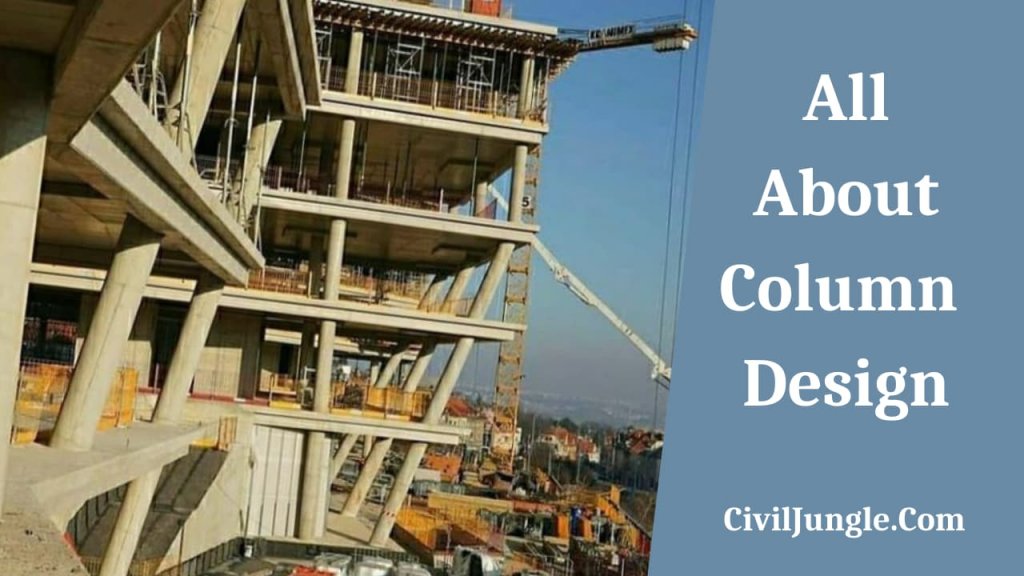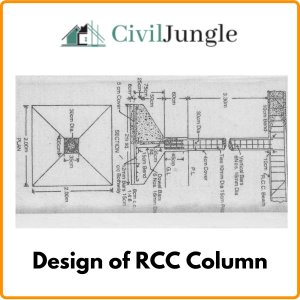Information of Column Design
Important Point
The column is an important vertical structural member in the building that helps to transfer the load of the building to the foundation. It creates a framework that withstands all the load of the structure.
The columns are designed to resist the axial loads and the lateral loads and transfer them effectively to the foundation of the structure.
So, as all the loads from beams, slabs are transferred through the columns, it is important to design strong columns. In this article, we will go through the detailed procedure of design of RCC column as per IS 456:2000. The column is defined as a compression member which has an effective length greater than its least lateral dimension.
Column length is three times the least lateral dimension of the cross-section. The main factors that govern the strength of the columns are their shape, size, and cross-section.
Also, Read: 10 Difference Between Mortar and Concrete | What Is Mortar & Concrete | Types of Mortar & Concrete
Design of RCC Column
Let us understand the column design procedure with one example
Design RCC column which is subjected to the axial load of 600 KN and the concrete used is of M-20 grade and steel Fe-500. Provide 1% steel and the factor of safety 1.5
Solution:
Fck = 20 N/mm2
FY = 500 N/mm2
Ag = Gross area of the column
Area of steel in concrete (ASC) = (1/100) x Ag
Area of concrete (Ac) = Gross area of column (Ag) – Area of steel (ASC) = Ag -0.01 Ag
Ac = 0.99 Ag
Pu = Axial load on column
Pu = load on column x Factor of safety
Pu = 600 x 1.5 = 900 KN
Following is the formula that is used for the design calculations of the RCC column for the building as per the IS 456:2000
Pu = 0.4 fck x Ac + 0.67 x FY x ASC
where,
Pu = Axial Load on the column
Fck = Characteristics compressive strength of the concrete
Ac = Area of concrete
FY = Characteristics Tensile strength of Steel
ASC = Area of steel reinforcement
Ac = Ag – ASC
ASC= 0.01 Ag
Ac = 0.99 Ag
Ag = Gross Area of Column
Consider 1% of steel in column
Ac = Ag – ASC
900 x 103 = 0.4 x 20 x (0.99Ag) + 0.67 x 500 x 0.01Ag
Ag = 79858 mm2
Also, Read: 81 Nos of List Use Construction Tools and Pieces of Equipment
RCC Column Size Calculation
For the calculation of the RCC Column size it is necessary that we should know essential parameters of the factored load on the column, grade of the steel and concrete used in the column.
The size of the column is calculated as per the load coming on the column from the superstructure. For the construction of the High Rise buildings, the size of the column is increased. The size of the column is a key factor that is considered for the designing of any structure.
Different sizes of the columns that are used in the designing of the buildings are as follows
- 9” x 9”
- 9” x 12”
- 12” x 12”
- 12″ x 15″
- 15″ x 18″
- 18″ x 18″
- 20″ x 24″
The minimum size of the column should not be less than 230 mm x 230 mm.
The more size of the columns can also be used depending upon the structural loads.
Also, Read: What Is Fresh Concrete | 8 Properties of Fresh Concrete
For RCC Column size calculation following data is required
- Grade of Concrete
- Grade of Steel
- Factored Load on Column
Shape of the column = square shape
Size of column = √ 79858 = 282.59 mm
So, providing the size of the column 285mm x 285mm
Gross Area provided = ( 285 mm x 285 mm ) = 81225 mm2
Area of steel provided in concrete (ASC) = 0.01 Ag
ASC = 0.01 x 81225
ASC= 812.25 mm2
Provide 8 nos 12 mm diameter of reinforcement bars having area of steel = 905 mm2
Also, Read: Top 20 AAC Block Company in India
RCC Column Design
Diameter of lateral ties as per the IS 456:2000
- ¼ x Diameter of larger bars = ¼ x 12 = 3 mm
- 8 mm
Provide larger of the above two values that is provide 8 mm diameter of the lateral ties
The pitch of the lateral Ties as per the IS:456
- Least lateral dimension = 285 mm
- 16 x Diameter of the smaller reinforcement bars = 192 mm
- 300 mm
Provide smaller whatever is of the above three values
Provide pitch = 190 mm
Provide 8 mm diameter of lateral ties at the 190 mm of center to center distance.
Beam Column
Structural members subjected to axial compression and bending are known as beam columns. The interaction of normal force and bending may be treated elastically or plastically using. Equilibrium for the classification of cross-section.
A Column
A column or pillar in architecture and structural engineering is a structural element that transmits, through compression, the weight of the structure above to other structural elements below. Columns are frequently used to support beams or arches on which the upper parts of walls or ceilings rest.
Column
The definition of a column is a vertical arrangement of something, a regular article in a paper, magazine or website, or a structure that holds something up. An example of column is an excel list of budget items. An example of column is a weekly recipe article.
Rcc Column
a reinforced concrete column is a structural member designed to carry compressive loads, composed of concrete with an embedded steel frame to provide reinforcement.
Different Types of Columns
Types of Columns In Civil Engineering
- Square or Rectangular Column
- Circular Column
- L and T shaped Column
- Tied Column
- Spiral Column
- Composite Column
- Axially Loaded Column
- Uniaxial Eccentrically Loaded Column
Column in Construction
A column or pillar in architecture and structural engineering is a structural element that transmits, through compression, the weight of the structure above to other structural elements below. Columns are frequently used to support beams or arches on which the upper parts of walls or ceilings rest.
Column Covers
Column cover systems. Help cover unsightly beams or concrete columns to offer a finished and durable appearance. Column covers can be manufactured out of plate or composite material in various finishes and textures.
Column Base
A column base consists of a column, a base plate and an anchoring assembly. In general they are designed with unstiffened base plates, but stiffened base plates may be used where the connection is required to transfer high bending moments.
Building Column
Column is a vertical structural member that carry loads mainly in compression. It might transfer loads from a ceiling, floor slab, roof slab, or from a beam, to a floor or foundations. Commonly, columns also carry bending moments about one or both of the cross-section axes. Types of columns in building construction.
Composite Column
Composite columns are a combination of two traditional structural forms: structural steel and structural concrete. As composite columns were generally developed after steel columns and reinforced concrete columns, their design approach could have been based on either steel or concrete design methods.
Rcc Column Reinforcement Details
As per IS code, the minimum dia of the longitudinal bar should not be less than 12 mm, and the dia of a stirrup should not be less than 8 mm. Stirrup should be placed at a distance of 150 mm (centre to centre distance).
Like this post? Share it with your friends!
Suggested Read –
- Area of Steel Formula in Rcc
- Top 10 Bathroom Fittings & Sanitary Brands India
- What Is Grouting | Types of Grouting | Advantage of Grouting
- What Does Parapet Mean | Types of Parapet Wall | Uses of Parapet Wall
- Cinder Block Vs Concrete Block | What Is Cinder Blocks | What Is Concrete Blocks
- What is BoQ | BoQ Meaning | Advantages of BoQ | What is BoM
- Soak Pit Design | Health Aspects | Operation and Maintenance of Soak Pit | Applicability of Soak Pit Design
- What Is Superelevation | Superelevation Definition | Superelevation Formula | Calculation of Superelevation in Roads
- Brick Masonry | 6 Types of Bricks | Types of Brick Masonry Work | 4 Types of Brick Bond | 5 Classification of Bricks Based on Size Modification





Leave a Reply